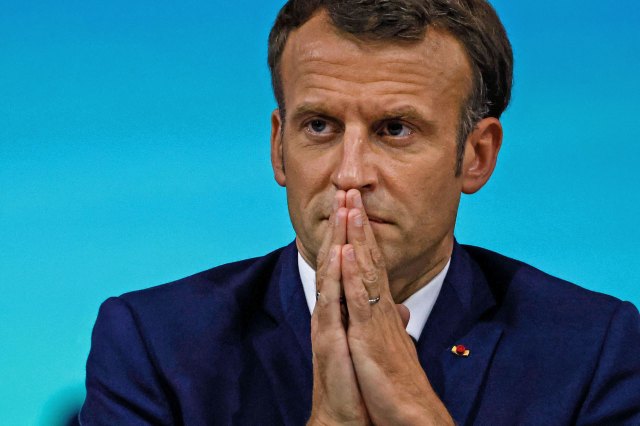He’s too proud to settle (Ludovic Marin/AFP/Getty Images)

In April, Emmanuel Macron became the first French president for two decades to win a second term. Two months later, he became the first French president in 34 years to be denied a parliamentary majority. French voters frequently complain that politicians never change anything — while protesting against any genuine attempts at change. In June they voted, deliberately or accidentally, for a deadlock.
Macron’s centrist alliance no longer had enough seats in the National Assembly to impose its will. No other group, or likely alliance, was large enough to dictate policy to the President. The result: stalemate. Or so it seemed. Two months on, no grand coalition has been formed. But nor is there a complete deadlock. Fears of instant chaos and early snap elections have proved exaggerated. France, after more than half a century of presidential, top-down politics, has rediscovered the messy joys of parliamentary democracy and verbal brawling.
Despite having 39 seats fewer than an overall majority, Macron’s prime minister, Elisabeth Borne, has managed to push through a €44 billion package of measures to blunt the impact of inflation. She may lack political experience, but she has proved to be a more effective parliamentary operator than many had predicted.
However, nothing difficult or truly controversial has yet been attempted. Deputies have been asked, in effect, to give away goodies to their constituents, including extending the price ceilings on gas and electricity, and subsidies on petrol and diesel prices. The unpleasant, uphill part of Macron’s second term is about to begin. September will see street marches for higher wages, as well as strikes and protests against the President’s proposed extension of the French retirement age to 64 and tougher rules for employment pay.
France is not a patient country: politics goes to the street more rapidly than in any other democracy. Macron’s opponents on the extremes of Right and Left now tell their supporters that his government is “illegitimate”. They say that the President does not represent a majority in parliament, let alone the country.
France is weathering the threat of Ukraine-war-generated stagflation reasonably well. Inflation is running at 6.1%, which is substantially less than in the UK and most other EU countries. Domestic power bills have been capped at 2021 levels or just above. Unemployment is still falling. But how long can Macron shield his nation from international inflationary forces? And what will it cost? Both the far-Left and far-Right are already pushing for the removal of sanctions against Russia. If Moscow cuts off EU gas supplies, the real cost of gas and electricity in France — and the cost to the state of subsidising them — will explode.
So far, some of the cost of France’s energy price gap has been concealed by imposing record losses on the largely state-owned power company, EDF. That cannot continue forever, even if the government carries through its plan to buy the remaining 16% of the company.
All this comes during a Sahel-like summer in which French forests burned and farmland across the country turned yellow. Yet Macron will struggle to rectify his patchy record on climate change in such a fragile economic environment. His government is due to present a grand strategy for moving to renewable energy next month: it will be dismissed as by the Left as too timid and the Right as too painful.
Macron knows that he is facing a winter of discontent. In a would-be Churchillian speech last Friday, he asked the French people to view their coming difficulties as “the price of liberty”. “I am thinking of our people,” he said, “and the strength of spirit they will need to… confront uncertainties, misleadingly simple responses and adversity and unite to accept that they must pay the price for our liberty and values.”
In other words, the President hopes to frame the autumn and winter protests as a narrow-minded refusal to accept that the West is in a prolonged state of economic war with Russia; and that the war is as much about protecting the future of France and other Western countries as it is about helping Ukraine. For this strategy to succeed, Macron needs to be consistent. It was foolish of him to be seen riding a fuel-guzzling jet ski on his summer break, while asking the French people to put up with energy shortages for the greater national good.
Macron and Borne face this tangled cat’s cradle of crises in the weakest position of any French government in half a century. Apart from a brief period in 1988-93, every president since 1965 has had a clear majority in the lower house of parliament.
Much depends on whether Macron and Borne can continue to form majorities in the National Assembly on an issue-by-issue basis. The signs are not encouraging: the centre-Right Les Républicains, who have propped up the Macron coalition so far, have already warned that they will vote symbolically against next year’s budget when the Assembly resumes in October. Borne could use emergency powers to push the budget through, but that would trigger a vote of confidence.
The present Assembly is split four ways, with fissures and tensions within each camp — including Macron’s own. Les Républicains, successors to the parties of Charles de Gaulle, Jacques Chirac and Nicolas Sarkozy, have been reduced to a rump of 62 seats out of 577. They have refused to join Macron’s centrist alliance — but have, however, supported the government in key votes, in return for Right-leaning shifts in policy, including a large, new breach in France’s 35-hour working week.
Members of the Left-wing alliance, Nupes (Nouvelle Union Populaire Ecologique et Sociale), the second-largest force in the assembly with 151 seats, have voted systematically against the government — albeit with one or two exceptions. They shout insults and wave their arms a great deal.
Meanwhile, Marine Le Pen’s unprecedented 89 deputies are under strict orders to appear calm and respectable. Some of the new Rassemblement National deputies find this discipline irksome. If Le Pen herself is absent, they too take the opportunity to hurl insults at Macron’s government. The RN has attacked the government on all its proposals but abstained this summer for fear of being seen to vote against inflation relief. Le Pen’s troops will not abstain this autumn and winter.
It’s clear that Les Républicains are the pivotal force in the new assembly, wielding power beyond their numbers. But they face an existential conundrum. They could either support Macron’s crisis-management policies and proposed reforms, giving him an against-the-odds triumph, or they could refuse to work with him and ensure that his second term is a failure. Some senior voices in the President’s camp are still hopeful that all or part of the centre-Right will agree next year to join a broader coalition. That is probably wishful thinking. There is a group of Républicains deputies ready to act as a rudder steering the government to the Right, on the economy, migration, and security. But others believe that helping Macron would destroy all hope of resurrecting the once dominant centre-Right and winning the 2027 presidential election. If they condemn the President to five years of muddle and drift, they say, they could bury Macronism and its would-be successors forever.
Much depends on who wins an internal election for Républicains party president in December. At its grassroots, the party is riven between its Macron-compatible, pro-European wing and the Macron-detesting nationalist-populists. The latter are almost certainly in the majority. The three leading candidates are likely to be Eric Ciotti, the Macron-hating, hard-Right deputy for Nice; the former European Commission Vice President, Michel Barnier; and a young, pragmatic deputy, Aurélien Pradié.
If Ciotti becomes the Républicains president, any alliance or systematic cooperation with Macron will be impossible. The Républicains parliamentary party might then split but that would not yield the 40 or so seats needed to create a stable, governing coalition.
By the end of the year, we will know whether the majority of the Assembly will support Macron’s flagship pension and employment law reforms. It will also be clear whether Macron and Borne can command ad hoc majorities to manage the triple interlocked crises of inflation, global recession, and war on the European continent.
If he cannot assemble the support, Macron will face a career-defining decision. In his first mandate, his reform agenda was overwhelmed by the Gilet Jaunes and Covid. Should he now accept a place in history as the young President who promised a great deal and achieved little? Or should he take the risk of dissolving the National Assembly and calling a new election?
Nothing in recent French politics suggests that Macron could expect a better result next year. French politicians rarely gain popularity while in office. One poll at the weekend showed the President sinking to 37% approval while his Prime Minister rose to 41%.
With an energy and inflation crisis, stretching into next spring, it is not the most obvious time to call an election. Asking French people to vote to work longer is unlikely to be a winning hand. Yet Macron is a young, energetic, and impulsive man. He will not easily settle for four years of posturing, drift and domestic and international firefighting.
His Blood, Sweat and Tears speech last week can be read in two ways. It could imply that he recognises that his only role in the next four years will be crisis-management — to prevent a deeply divided France from falling apart. Or it could suggest that he sees the coming multi-layered crises as an opportunity to assemble a broad, consensual centre against the extremes of Left and Right. Some senior Macron supporters believe that he will be tempted by next June to call an election in which he would campaign — to quote his speech — for “unity in adversity”. I can only say: good luck with that.









